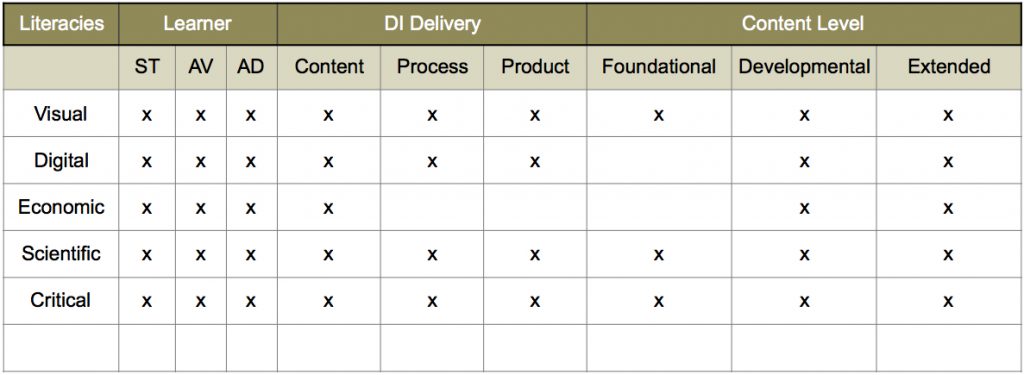This last exhibit allows students to continue “learning from the past, [to] gain insight into the currency of today” (Tincher, 2016, Module 3, Part 2) by furthering their exploration of what it means to be a paleontologist. Adding to research, challenging ideas, and completely reformulating understandings are part of the currency of scientific learning. Students will engage in this process through further research, and positing their ideas about dinosaur extinction. Formative assessment and feedback are systematically planned (Tincher, 2016, Module 4, Part 4) through the sharing of ideas and findings, granting the students the chance to improve or modify their work based on feedback given.
Students will use inquiry to engage both their hands and their minds (Ajaja, 2013, p.2) as they create representations of their dinosaur utilizing the information they have gleaned. The inquiry process causes them to not only reflect on their learning but help them to begin to understand their individual learning process ( Maniotes & Kuhlthau, 2014, p. 14). The end goal of this exhibit is for all students to create their own ‘museum’ to display their learning. In creating a museum, students are thrust into the role of curator using critical, scientific and visual literacy skills to decide “what is worth displaying” (Tincher, 2016, Module 4, Part 1), how best they might display what they have learned, and how their display engages viewers. In being viewers of this Museum, they now are given the opportunity to become “prosumers” (Lin, Li, Deng & Lee, 2013, p. 162) appropriating and recontextualizing their research to create a multi-modal presentation.
In exploring dinosaur extinction, students will have the chance to create an online cartoon depicting how they think dinosaurs became extinct. While being an exciting way to represent ideas this activity also “creates space[s] for new critical practice[s] to emerge” (Pandya & Pagdilao, 2015, p. 39). Again, students are exposed to the shift new literacies have brought into learning by manipulating and recontextualizing information to create meaning (Higgins, 2014, p.561).

References
Ajaja, O. P. (2013). What strategy best suits biology teaching? Lecturing, concept mapping, cooperative learning or learning cycle? Electronic Journal of Science Education, 17(1), 1-17.
Conty, (2009). Dinosaur Size. [Image] Retrieved from https://commons.wikimedia.org/w/index.php?curid=6429413
Dinosaur Size. (n.d.). In Wikipedia. Retrieved August 5, 2016, from https://en.wikipedia.org/wiki/Dinosaur_size
Dinosaur Size Comparison Table (n.d.). In Wikipedia. Retrieved August 5, 2016, from https://en.wikipedia.org/wiki/User:Colin_Douglas_Howell/Galleries/Dinosauria_size_comparison_table
Dufresne, M. (2016). I Wonder What Happened to the Dinosaurs? [Image]. Retrieved from https://www.pixton.com/create/comic-strip/gdbldkzk
Gould, S. & Orwig, J. (2015, June 12). How Humans Size Up to the Dinosaurs from Jurassic Park. Business Insider. Retrieved from http://www.businessinsider.com/dinosaur-size-comparison-chart-2015-6
Higgins, S. (2014). Critical thinking for 21st-century education: A cyber-tooth curriculum?. Prospects, 44(4), 559-574.
Lin, T-B., Li, J-Y., Deng, F., & Lee, L. (2013). Understanding new media literacy: An explorative theoretical framework. Journal of Educational Technology & Society, 16(4), 160-170.
Maniotes, L. K., & Kuhlthau, C. C. (2014). Making the shift: From traditional research assignments to guiding inquiry learning. Knowledge Quest, 43(2), 8-17.
Pandya, J. Z., & Pagdilao, K. C. (2015).”It’s complicated”: Children learning about other people’s lives through a critical digital literacies project. Australian Journal of Language & Literacy, 38(1), 38-45.
Pavitt, D., ( 2016). Marching Dinosaurs – Animated Size Comparison. [Video file]. Retrieved from https://www.youtube.com/watch?v=rRiecAmGWHU
Tincher, D. L. (Course Lecture). (2016). 21st Century Literacies. Modules 3 and 4 [Video Embed]. American College of Education. Retrieved from: http://ace.edu